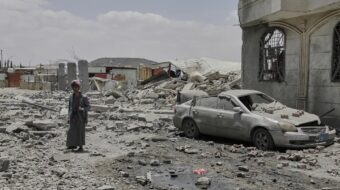Dramatic message to polar summit
Mother Nature sent a dramatic message to a global summit on the Arctic and Antarctic that opened this morning in Baltimore: On Saturday, an ice bridge that is believed to hold a vast Antarctic ice shelf in place broke up. It could mean a wider collapse of polar ice, scientists say. That could lead to glacier flows into the sea, and spur rising world sea levels. Global warming is considered the chief culprit.
A satellite image on Saturday showed a 25-mile-long strip of ice believed to pin the Wilkins Ice Shelf in place had splintered at its narrowest point, about a third of a mile wide. In 1950, the ice bridge was almost 62 miles wide.
Temperatures on the Antarctic Peninsula have risen by as much as 5 degrees Fahrenheit in the past 50 years, the fastest rate of warming in the Southern Hemisphere.
Secretary of State Hillary Rodham Clinton told world diplomats gathered for the polar conference this morning that the U.S. will push for more restrictions on tourism to the North and South Poles to protect the regions’ natural environment and help avoid the worst effects of global warming. Clinton warned that protecting the region was crucial to stabilizing the global climate.
‘The changes under way in the Arctic will have long-term impacts on our economic future, our energy future and indeed again the future of our planet,” she said.
The summit, which runs until April 17, is the first joint meeting of signers of the 1959 Antarctic Treaty and members of the Arctic Council, which covers the northern polar region. It includes more than 400 scientists and government officials from 47 countries, and is the first U.S.-hosted summit on the environment since President Barack Obama took office.
The Baltimore meeting marks the 50th anniversary of the signing of the Antarctic Treaty. Many consider it the first modern international arms control treaty. It says Antarctica is a peaceful ‘natural reserve’ that cannot be used for military purposes, and guarantees freedom for scientific investigations. The pact has 46 member states.
The Antarctic’s Wilkins ice shelf is currently about the size of the state of Connecticut. Saturday’s loss of the ice bridge may allow ocean currents to wash away far more of the shelf, David Vaughan, a glaciologist with the British Antarctic Survey, told Reuters.
The Wilkins shelf is one of 10 Antarctic ice shelves that have shrunk or collapsed in the past 50 years. Some of them had been in place for at least 10,000 years, based on dating of seabed sediments.
The Arctic is experiencing similar changes. Last August, a huge 19-square-mile ice shelf in Canada’s northern Arctic broke away and scientists said the remaining shelves have shrunk at a ‘massive and disturbing’ rate.
The scientists said the Markham Ice Shelf, one of just five remaining ice shelves in the Canadian Arctic, split away from Ellesmere Island. They also said two large chunks totaling 47 square miles had broken off the nearby Serson Ice Shelf, reducing its size by 60 percent.
‘The changes … were massive and disturbing,’ said Warwick Vincent, director of the Centre for Northern Studies at Laval University in Quebec.
Temperatures in large parts of the Arctic have risen far faster than the global average in recent decades, a development that experts say is linked to global warming.
Last summer’s ice shelf break-offs “underscore the rapidity of changes taking place in the Arctic,’ Derek Mueller, an Arctic ice shelf specialist at Trent University in Ontario, told Reuters.
‘These changes are irreversible under the present climate and indicate that the environmental conditions that have kept these ice shelves in balance for thousands of years are no longer present,’ he said.
Scientists warn that global warming is having a significant impact on the world’s polar regions. And melting Arctic ice could cause a dangerous rise in global sea levels, flooding some coastlines and accelerating the impact of climate change around the world.
A study by NASA released alongside the polar summit found that Arctic ice was melting, and thinning, at a faster rate than expected. According to Science Daily, the new research says the Arctic might lose most of its ice cover in summer in as few as 30 years.
Scientists also say the melting ice shelves contain unique ecosystems which will not be replaced.
Clinton told the polar summit that past agreements on protecting the poles served as a ‘living example’ of governments’ ability to cooperate on environmental issues, and urged similar cooperation in the lead-up to a crucial Copenhagen summit on climate change at the end of the year.
‘As the world prepares for climate talks in Copenhagen this December, meetings like this are more important than ever,’ she said.










